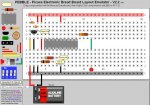Power Supplies 101
The components that you need for a power supply is somewhat dependant upon the source of power, the required voltage and the total load current.
Source of supply can include (but is not limited to):
1. batteries up to 5Vdc
2. well regulated dc output plug pack (wall wart) up to 5Vdc
3. well regulated dc output plug pack from around 8Vdc to 10Vdc
4. un regulated dc output plug pack from around 8Volts to 10Volts
5. ac output plug pack from around 8V to 10V
For 1 and 2 nothing further is required.
For 3 a voltage regulator is required to reduce the voltage to 5Vdc.
For 4, implied rectified but unfiltered/regulated so we need an electrolytic type capacitor followed by a voltage regulator
For 5, we need a rectifier (full wave is best), an electrolytic capacitor and a voltage regulator.
In each case where a voltage regulator is used, to help prevent the regulator output from oscillating, many manufacturers recommend a tantalum capacitor across the output.
Optional by me but maybe compulsory by others, is to add some ceramic capacitors also on the output and maybe the input of the voltage regulator.
With battery supplies, ff the battery capacity (in mAhr) is small and there might be relatively high load currents, it can be recommended to include an electrolytic or tantalum capacitor as a form of “buffer” to help smooth out voltage dips when there is a high load current surge.
Required Voltage –typically for a PICAXE chip and most support chips a 5V regulator is used. However some devices and modules can require other voltages such as 3Vdc. I have LCD modules out of mobile phones and humidity sensors in this latter group.
Load current can determine which specific voltage regulator chip you will require.
78L05 and LP2950-5 are 5Vdc output regulators that can supply a maximum current of 100mA. The LP series is a low drop out type which only require the input voltage to be from 50mA to ~400mV greater than the output voltage.
For higher currents the 7805 type voltage regulator is rated to supply 1 Amp. They require the input voltage to be at least 2 volts greater than the output voltage.
If the current is greater that around 300mA and/or the input voltage is more than about 8 volts then a heat sink is required as these linear voltage regulators do generate heat proportional to the current and input to output voltage difference.
At greater cost but quite compact, you can purchase switch mode voltage regulators that are very efficient and thus generate little heat so they do not need a heatsink.
It is also often recommended to add a ceramic type capacitor (100nF) across the supply for each IC in your circuit. These help to filter spikes/noise caused as the IC internal logic is switching form one state to another.
All of the above is somewhat general, however as you can see, before someone can give you an exact circuit more information would be needed. Your different projects over time may also need different circuits.

